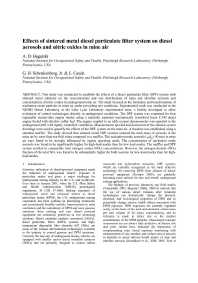Mining Publication: Effects of Sintered Metal Diesel Particulate Filter System on Diesel Aerosols and Nitric Oxides in Mine Air
Original creation date: June 2008
This study was conducted to establish the effects of a diesel particulate filter (DPF) system with sintered metal substrate on the concentrations and size distributions of nano and ultrafine aerosols and concentrations of nitric oxides in underground mine air. The study focused on the formation and transformation of nucleation mode particles in mine air under prevailing test conditions. Experimental work was conducted in the NIOSH Diesel Laboratory at the Lake Lynn Laboratory experimental mine, a facility developed to allow evaluation of control technologies directly in underground conditions. The DPF system was examined for four repeatable steady-state engine modes using a naturally aspirated mechanically controlled Isuzu C240 diesel engine fueled with ultralow sulfur fuel. The engine coupled to an eddy-current dynamometer was operated in the underground drift with tightly controlled ventilation. Measurements upwind and downwind of the exhaust system discharge were used to quantify the effects of the DPF system on the mine air. A baseline was established using a standard muffler. The study showed that sintered metal DPF systems reduced the total mass of aerosols in the mine air by more than ten-fold when compared to a muffler. The nucleation mode aerosols (50dem<40 nm) in mine air were found to be strongly influenced by engine operating mode. The concentration of nucleation aerosols was significantly higher for high-load modes than low-load modes. The muffler and dpf system resulted in comparable total nitrogen oxides (NOx) concentrations. However, the nitrogen dioxide (NO2) fraction of the total NOx was found to be substantially higher for both systems for low-load modes than for highload modes.
Authors: AD Bugarski, GH Schnakenberg, E Cauda
Conference Paper - June 2008
NIOSHTIC2 Number: 20034162
Proceedings of the 12th U.S./North American Mine Ventilation Symposium, Reno, Nevada, June 9-11, 2008. Wallace, Jr. KG. ed., Reno, NV: University of Nevada - Reno, 2008; :337-345
See Also
- Comparing Measurements of Carbon in Diesel Exhaust Aerosols Using the Aethalometer, NIOSH Method 5040, and SMPS
- Control Technologies and Strategies for Reducing Exposure of Underground Miners to Diesel Emissions
- DEEP Project on Evaluation of Diesel Particulate Filters at Inco's Stobie Mine
- Diesel Aerosols and Gases in Underground Mines: Guide to Exposure Assessment and Control
- Effectiveness of Selected Diesel Particulate Matter Control Technologies for Underground Mining Applications: Isolated Zone Study, 2004
- Effects of Diesel Exhaust Aftertreatment Devices on Concentrations and Size Distribution of Aerosols in Underground Mine Air
- The Effects of Passive Diesel Particulate Filters on Diesel Particulate Matter Concentrations in Two Underground Metal/Nonmetal Mines
- Evaluation of the SKC® DPM Cassette for Monitoring Diesel Particulate Matter in Coal Mines
- Examination of Diesel Aftertreatment Systems at NIOSH Lake Lynn Laboratory
- Mutagenicity of Diesel Exhaust Particles from an Engine with Differing Exhaust After Treatments
- Page last reviewed: 9/21/2012
- Page last updated: 9/21/2012
- Content source: National Institute for Occupational Safety and Health, Mining Program


 ShareCompartir
ShareCompartir
